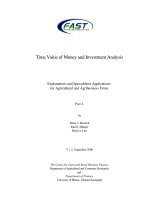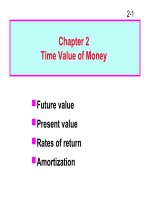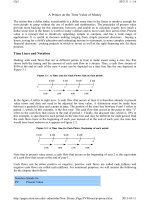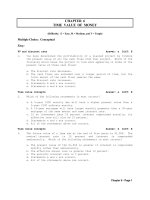Chapter 4 time value of money
Bạn đang xem bản rút gọn của tài liệu. Xem và tải ngay bản đầy đủ của tài liệu tại đây (606.23 KB, 40 trang )
PowerPoint
to accompany
Chapter 4
Time Value Of
Money
Learning Goals:
•
Discuss the role of time value in finance and the basic
patterns of cash flows.
•
Understand present and future value.
•
Describe annuities, and perpetuities.
•
Find future/present values of a stream of cash flows.
•
Understand the effect of frequently compounding
interest.
ã
Determine amortisation parameters.
Copyright â 2011 Pearson Australia (a division of Pearson Australia Group Pty Ltd) –
9781442518193/ Gitman et al / Principles of Managerial Finance / 6th edition
The Role Of Time Value
•
The “time value of money” principle says that all
things being equal, a dollar today is worth more
than a dollar that will be received at some future
date.
Financial values and decisions can be assessed
by considering:
Future Value
Present Value
Copyright © 2011 Pearson Australia (a division of Pearson Australia Group Pty Ltd) –
9781442518193/ Gitman et al / Principles of Managerial Finance / 6th edition
The Role Of Time Value
•
Future cash flows are best depicted through the
use of a timeline:
Cash Flows On
Top
Time On Bottom
Copyright © 2011 Pearson Australia (a division of Pearson Australia Group Pty Ltd) –
9781442518193/ Gitman et al / Principles of Managerial Finance / 6th edition
Compounding & Discounting
Page 147.
Copyright © 2011 Pearson Australia (a division of Pearson Australia Group Pty Ltd) –
9781442518193/ Gitman et al / Principles of Managerial Finance / 6th edition
Useful Calculation Tools
Formulas Formula Sheet.pdf
Financial Tables – Appendix AFinancial
Tables.pdf
Electronic SpreadsheetsAnnuity.xls
Financial Calculators
Page 147.
Copyright © 2011 Pearson Australia (a division of Pearson Australia Group Pty Ltd) –
9781442518193/ Gitman et al / Principles of Managerial Finance / 6th edition
Financial TablesFinancial
Tables.pdf
Page 148.
Copyright © 2011 Pearson Australia (a division of Pearson Australia Group Pty Ltd) –
9781442518193/ Gitman et al / Principles of Managerial Finance / 6th edition
Basic Cash Flow Patterns
Single Amount: One lump sum.
Annuity: Series of cash flows of equal amount,
received at equal time intervals.
Mixed Stream: Series of cash flows that are not
equal or a series of cash flows that are not
received at equal time intervals.
Copyright © 2011 Pearson Australia (a division of Pearson Australia Group Pty Ltd) –
9781442518193/ Gitman et al / Principles of Managerial Finance / 6th edition
Future Value Of A Single
Amount
Future Value: the value of a present amount at a
future date (Go to excel sheet) .
Calculated by applying compound interest over a
specified period of time.
FVn = PV x (1 + i)n [Equation 4.4]
Where:
FVn = Future value at the end of period n
PV = Present value
i = Annual interest rate
n = Number of periods
Copyright © 2011 Pearson Australia (a division of Pearson Australia Group Pty Ltd) –
9781442518193/ Gitman et al / Principles of Managerial Finance / 6th edition
Future Value Of A Single
Amount
Future Value Interest Factor (FVIF): the multiplier
used to calculate FV at a given discount rate.
•
Written as FVIFi,n
•
FVIFi,n = (1 + i)n [Equation 4.5] Financial
Tables.pdf
•
FVn = PV x FVIFi,n [Equation 4.6]
Copyright © 2011 Pearson Australia (a division of Pearson Australia Group Pty Ltd) –
9781442518193/ Gitman et al / Principles of Managerial Finance / 6th edition
Future Value Of A Single
Amount
Example: Jane Farber places $800 in a savings
account paying 6% interest compounded annually.
She wants to know how much money will be in the
account at the end of five years. Formula Sheet.pdf
Formula:
FVn = PV x (1 + i)n
= 800 x (1 + 0.06) 5
= $1,070.58
Copyright © 2011 Pearson Australia (a division of Pearson Australia Group Pty Ltd) –
9781442518193/ Gitman et al / Principles of Managerial Finance / 6th edition
Future Value Of A Single
Amount
Financial Calculator:
i = 6, PV = -800, n = 5
FVn = $1,070.58
Financial Tables: (Using Appendix A-1)
FVn = PV x FVIFi,n
FVn = 800 x 1.338
FVn = $1,070.40
Copyright © 2011 Pearson Australia (a division of Pearson Australia Group Pty Ltd) –
9781442518193/ Gitman et al / Principles of Managerial Finance / 6th edition
Future Value Relationship
Page 153.
Copyright © 2011 Pearson Australia (a division of Pearson Australia Group Pty Ltd) –
9781442518193/ Gitman et al / Principles of Managerial Finance / 6th edition
Present Value Of A Single
Amount
Present Value: the current value of a future amount.
Calculated by discounting cash flows over a
specified period of time.
Copyright © 2011 Pearson Australia (a division of Pearson Australia Group Pty Ltd) –
9781442518193/ Gitman et al / Principles of Managerial Finance / 6th edition
Present Value Of A Single
Amount
Present Value Interest Factor (FVIF): the multiplier
used to calculate PV at a given discount rate.
•
Written as PVIFi,nFinancial Tables.pdf
Copyright © 2011 Pearson Australia (a division of Pearson Australia Group Pty Ltd) –
9781442518193/ Gitman et al / Principles of Managerial Finance / 6th edition
Present Value Of A Single
Amount
Example: Pam Valentine wishes to find the
present value of $1,700 that will be received eight
years from now. Pam’s opportunity cost is 8%.
Formula:
PV =
FVn
(1 + i)n
=
1,700
(1 + 0.08) 8
= $918.46
Copyright © 2011 Pearson Australia (a division of Pearson Australia Group Pty Ltd) –
9781442518193/ Gitman et al / Principles of Managerial Finance / 6th edition
Present Value Of A Single
Amount
Financial Calculator:
i = 8, FV = 1,700 , n = 8
PV = $918.46
Financial Tables: (Using Appendix A-3)Financial
Tables.pdf
PV = FVn x PVIFi, n
PV = 1,700 x 0.540
PV = $918.00
Copyright © 2011 Pearson Australia (a division of Pearson Australia Group Pty Ltd) –
9781442518193/ Gitman et al / Principles of Managerial Finance / 6th edition
Present Value Relationship
Page 156.
Copyright © 2011 Pearson Australia (a division of Pearson Australia Group Pty Ltd) –
9781442518193/ Gitman et al / Principles of Managerial Finance / 6th edition
Annuities
Annuity: a stream of equal periodic cash flows
over a specified time period.
Two types:
1.
2.
Ordinary Annuity: Cash flow occurs at the end
of each period.
Annuity Due: Cash flow occurs at the
beginning of each period.
Unless otherwise stated, in finance the term
annuity refers to ordinary annuities.
Copyright © 2011 Pearson Australia (a division of Pearson Australia Group Pty Ltd) –
9781442518193/ Gitman et al / Principles of Managerial Finance / 6th edition
Future Value Of An Ordinary
Annuity
Calculated by summing the future value of all future
cash flows
FVIFAi,n = (1 + i)t–1 [Equation 4.13]Financial Tables.pdf
FVAn = PMT x FVIFAi,n
[Equation 4.14]
Where:
FVAn = Future value of an annuity at the end of
period n
FVIFAi,n = Future value interest factor - annuity
Copyright © 2011 Pearson Australia (a division of Pearson Australia Group Pty Ltd) –
9781442518193/ Gitman et al / Principles of Managerial Finance / 6th edition
Present Value Of An Ordinary
Annuity
Calculated by summing the present value of all future
cash flows.Financial Tables.pdf
PVAn = PMT x PVIFAi.n [Equation 4.16]
Where:
PVAn = Present value of an annuity at the end of
period n.
PVIFAi,n = Present value interest factor – annuity.
Copyright © 2011 Pearson Australia (a division of Pearson Australia Group Pty Ltd) –
9781442518193/ Gitman et al / Principles of Managerial Finance / 6th edition
Future Value Of An Annuity
Due
Earns interest for a year more than an ordinary
annuity, as the cash flows occur at the start of the
period.
[Equation 4.17]
Copyright © 2011 Pearson Australia (a division of Pearson Australia Group Pty Ltd) –
9781442518193/ Gitman et al / Principles of Managerial Finance / 6th edition
Present Value Of An Annuity
Due
As the first annuity occurs at the beginning of the first
period, the annuity must be discounted back one
less year than for an ordinary annuity.
[Equation 4.18]
Copyright © 2011 Pearson Australia (a division of Pearson Australia Group Pty Ltd) –
9781442518193/ Gitman et al / Principles of Managerial Finance / 6th edition
Perpetuities
An ordinary annuity with an infinite life.
PVIFA i, ∞ = 1
i
[Equation 4.19]
PVA ∞ = PMT x PVIFAi, ∞yrs
Where:
∞ = infinite number of periods
Copyright © 2011 Pearson Australia (a division of Pearson Australia Group Pty Ltd) –
9781442518193/ Gitman et al / Principles of Managerial Finance / 6th edition
Mixed Streams
A series of unequal periodic cash flows with no
particular pattern.
Future Value Of A Mixed Stream: Calculated by
adding together the future values of each cash
flow at the specified future dates.
Present Value Of A Mixed Stream: Calculated by
adding together the present values of each future
cash flow.
Copyright © 2011 Pearson Australia (a division of Pearson Australia Group Pty Ltd) –
9781442518193/ Gitman et al / Principles of Managerial Finance / 6th edition









